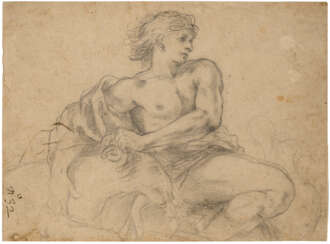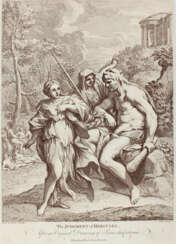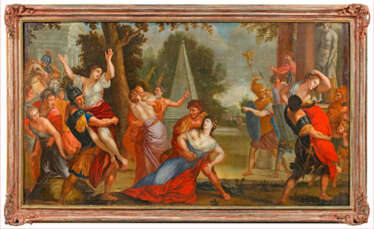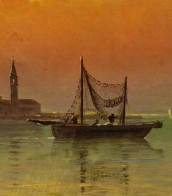pietro da cortona (1596 - 1669)
Pietro da Cortona, born as Pietro Berrettini, was an eminent figure in the Italian Baroque movement. His multi-faceted genius encompassed painting, architecture, and design, earning him a reputation second only to Bernini in the Roman Baroque style. Cortona's journey in art commenced in Rome around 1612, where his talents flourished under the patronage of influential families like the Barberini.
Pietro da Cortona's masterful frescoes in the church of S. Bibiana, commissioned by Urban VIII, set the tone for his illustrious career. His most iconic work, the colossal fresco "Allegory of Divine Providence and Barberini Power" in the Gran Salone of the Palazzo Barberini, epitomizes his skill in creating grandiose, illusionistic art. This piece, commenced in 1633 and completed in 1639, is a testament to his belief in the epic scale of history painting, a view he defended in a notable debate with Andrea Sacchi.
In 1637, Pietro da Cortona's artistic journey took him to Florence at the behest of Ferdinand II de' Medici, Grand Duke of Tuscany. Here, in the Palazzo Pitti, he created frescoes for the Planetary Rooms, combining allegorical themes with lush stucco work, significantly influencing the Italian and French decorative arts.
Pietro da Cortona's contributions to architecture were equally significant. His architectural masterpiece, the church of SS. Martina e Luca in Rome, exemplifies his ability to create grand structures with a unified Baroque vision. His architectural prowess, though less correlated with his painting style, made a lasting impact through its emphasis on form rather than ornament.
For art collectors and enthusiasts, Pietro da Cortona's works offer a rich tapestry of Baroque artistry, blending grandeur, realism, and allegory. His frescoes, paintings, and architectural designs continue to captivate audiences, symbolizing the opulence and dynamism of the Baroque era.
To stay updated on the latest insights and collections related to Pietro da Cortona, consider subscribing to our updates. Stay informed about new sales, exhibitions, and auction events related to this master of the Baroque style.

Pietro da Cortona, born as Pietro Berrettini, was an eminent figure in the Italian Baroque movement. His multi-faceted genius encompassed painting, architecture, and design, earning him a reputation second only to Bernini in the Roman Baroque style. Cortona's journey in art commenced in Rome around 1612, where his talents flourished under the patronage of influential families like the Barberini.
Pietro da Cortona's masterful frescoes in the church of S. Bibiana, commissioned by Urban VIII, set the tone for his illustrious career. His most iconic work, the colossal fresco "Allegory of Divine Providence and Barberini Power" in the Gran Salone of the Palazzo Barberini, epitomizes his skill in creating grandiose, illusionistic art. This piece, commenced in 1633 and completed in 1639, is a testament to his belief in the epic scale of history painting, a view he defended in a notable debate with Andrea Sacchi.
In 1637, Pietro da Cortona's artistic journey took him to Florence at the behest of Ferdinand II de' Medici, Grand Duke of Tuscany. Here, in the Palazzo Pitti, he created frescoes for the Planetary Rooms, combining allegorical themes with lush stucco work, significantly influencing the Italian and French decorative arts.
Pietro da Cortona's contributions to architecture were equally significant. His architectural masterpiece, the church of SS. Martina e Luca in Rome, exemplifies his ability to create grand structures with a unified Baroque vision. His architectural prowess, though less correlated with his painting style, made a lasting impact through its emphasis on form rather than ornament.
For art collectors and enthusiasts, Pietro da Cortona's works offer a rich tapestry of Baroque artistry, blending grandeur, realism, and allegory. His frescoes, paintings, and architectural designs continue to captivate audiences, symbolizing the opulence and dynamism of the Baroque era.
To stay updated on the latest insights and collections related to Pietro da Cortona, consider subscribing to our updates. Stay informed about new sales, exhibitions, and auction events related to this master of the Baroque style.

Pietro da Cortona, born as Pietro Berrettini, was an eminent figure in the Italian Baroque movement. His multi-faceted genius encompassed painting, architecture, and design, earning him a reputation second only to Bernini in the Roman Baroque style. Cortona's journey in art commenced in Rome around 1612, where his talents flourished under the patronage of influential families like the Barberini.
Pietro da Cortona's masterful frescoes in the church of S. Bibiana, commissioned by Urban VIII, set the tone for his illustrious career. His most iconic work, the colossal fresco "Allegory of Divine Providence and Barberini Power" in the Gran Salone of the Palazzo Barberini, epitomizes his skill in creating grandiose, illusionistic art. This piece, commenced in 1633 and completed in 1639, is a testament to his belief in the epic scale of history painting, a view he defended in a notable debate with Andrea Sacchi.
In 1637, Pietro da Cortona's artistic journey took him to Florence at the behest of Ferdinand II de' Medici, Grand Duke of Tuscany. Here, in the Palazzo Pitti, he created frescoes for the Planetary Rooms, combining allegorical themes with lush stucco work, significantly influencing the Italian and French decorative arts.
Pietro da Cortona's contributions to architecture were equally significant. His architectural masterpiece, the church of SS. Martina e Luca in Rome, exemplifies his ability to create grand structures with a unified Baroque vision. His architectural prowess, though less correlated with his painting style, made a lasting impact through its emphasis on form rather than ornament.
For art collectors and enthusiasts, Pietro da Cortona's works offer a rich tapestry of Baroque artistry, blending grandeur, realism, and allegory. His frescoes, paintings, and architectural designs continue to captivate audiences, symbolizing the opulence and dynamism of the Baroque era.
To stay updated on the latest insights and collections related to Pietro da Cortona, consider subscribing to our updates. Stay informed about new sales, exhibitions, and auction events related to this master of the Baroque style.

Pietro da Cortona, born as Pietro Berrettini, was an eminent figure in the Italian Baroque movement. His multi-faceted genius encompassed painting, architecture, and design, earning him a reputation second only to Bernini in the Roman Baroque style. Cortona's journey in art commenced in Rome around 1612, where his talents flourished under the patronage of influential families like the Barberini.
Pietro da Cortona's masterful frescoes in the church of S. Bibiana, commissioned by Urban VIII, set the tone for his illustrious career. His most iconic work, the colossal fresco "Allegory of Divine Providence and Barberini Power" in the Gran Salone of the Palazzo Barberini, epitomizes his skill in creating grandiose, illusionistic art. This piece, commenced in 1633 and completed in 1639, is a testament to his belief in the epic scale of history painting, a view he defended in a notable debate with Andrea Sacchi.
In 1637, Pietro da Cortona's artistic journey took him to Florence at the behest of Ferdinand II de' Medici, Grand Duke of Tuscany. Here, in the Palazzo Pitti, he created frescoes for the Planetary Rooms, combining allegorical themes with lush stucco work, significantly influencing the Italian and French decorative arts.
Pietro da Cortona's contributions to architecture were equally significant. His architectural masterpiece, the church of SS. Martina e Luca in Rome, exemplifies his ability to create grand structures with a unified Baroque vision. His architectural prowess, though less correlated with his painting style, made a lasting impact through its emphasis on form rather than ornament.
For art collectors and enthusiasts, Pietro da Cortona's works offer a rich tapestry of Baroque artistry, blending grandeur, realism, and allegory. His frescoes, paintings, and architectural designs continue to captivate audiences, symbolizing the opulence and dynamism of the Baroque era.
To stay updated on the latest insights and collections related to Pietro da Cortona, consider subscribing to our updates. Stay informed about new sales, exhibitions, and auction events related to this master of the Baroque style.

Pietro da Cortona, born as Pietro Berrettini, was an eminent figure in the Italian Baroque movement. His multi-faceted genius encompassed painting, architecture, and design, earning him a reputation second only to Bernini in the Roman Baroque style. Cortona's journey in art commenced in Rome around 1612, where his talents flourished under the patronage of influential families like the Barberini.
Pietro da Cortona's masterful frescoes in the church of S. Bibiana, commissioned by Urban VIII, set the tone for his illustrious career. His most iconic work, the colossal fresco "Allegory of Divine Providence and Barberini Power" in the Gran Salone of the Palazzo Barberini, epitomizes his skill in creating grandiose, illusionistic art. This piece, commenced in 1633 and completed in 1639, is a testament to his belief in the epic scale of history painting, a view he defended in a notable debate with Andrea Sacchi.
In 1637, Pietro da Cortona's artistic journey took him to Florence at the behest of Ferdinand II de' Medici, Grand Duke of Tuscany. Here, in the Palazzo Pitti, he created frescoes for the Planetary Rooms, combining allegorical themes with lush stucco work, significantly influencing the Italian and French decorative arts.
Pietro da Cortona's contributions to architecture were equally significant. His architectural masterpiece, the church of SS. Martina e Luca in Rome, exemplifies his ability to create grand structures with a unified Baroque vision. His architectural prowess, though less correlated with his painting style, made a lasting impact through its emphasis on form rather than ornament.
For art collectors and enthusiasts, Pietro da Cortona's works offer a rich tapestry of Baroque artistry, blending grandeur, realism, and allegory. His frescoes, paintings, and architectural designs continue to captivate audiences, symbolizing the opulence and dynamism of the Baroque era.
To stay updated on the latest insights and collections related to Pietro da Cortona, consider subscribing to our updates. Stay informed about new sales, exhibitions, and auction events related to this master of the Baroque style.





































